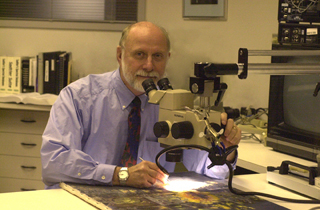Research Microscopy and Scientific Imaging
 |
|
|
Joe Barabe at work
Photograph courtesy of Barabe
|
|
|
|
|
|
|
Joe Barabe, of McCrone Associates, analyzes and authenticates art objects and historical and archaeological artifacts. Barabe works with tools such as spectrometry, spectroscopy, polarized-light microscopy, chromotography, carbon dating, and thermoluminescence to discover the origin and history of objects that come into his laboratory. Most of Barabe’s clients are museums, which generally do not have the more expensive and complex equipment needed to perform these analyses. McCrone Associates, an internationally-known laboratory, has executed a number of examinations for the Art Institute.
There are three integral parts of the authentication process: style, provenance, and materials analysis. After identifying the materials used in a particular work of art, scientists answer the following questions: Were these materials available to the artist at the time of creation during his or her lifetime? Are the materials appropriate to the period, style, and culture indicated? The scientist will decide if the work is authentic if, among other factors, the materials are consistent with the time and place of the artist's lifetime. Barabe had used this technology to discover inauthentic works of art—either forgeries or misattributions—which have been altered or reproduced in some way.
Pigment identification is important to authentication because each pigment has its own date of invention. In one investigation, Barabe questioned the authenticity of a portrait of the well-known artist J.A.M. Whistler by another late-19th century artist, Mortimer Menpes. After discovering the presence of titanium white, a pigment essential in modern painting but not available until after 1920, he declared the work a forgery.
One of the more controversial examinations done by McCrone Lab in the 1970s was on the Shroud of Turin (date unknown). Very small, highly refractive, deep reddish-brown particles were found on the shroud. Scientists analyzed tapelets (tape that had been touched to sample areas of the painting) and found red pigment particles. These areas, thought previously to be blood, were actually made of red ochre and vermilion (common Medieval pigments). To affirm this finding, the piece was also tested for blood using sodium nitrite, which yielded negative results. If the blood particles had been real, nitrogen bubbles would have formed. The medium turned out to be a boiled gelatin or thin watercolor.
Scientists use a variety of analytical tools to examine pigments, including polarized light microscopy, which may be used to reveal color, particle size, and refractive index; infrared spectrometry, which may be used to distinguish organic or synthetic pigments (such as real amber from fake amber, which have the same surface appearance); and Raman spectroscopy, which determines the individual spectrum of a pigment sample. Samples are typically taken with a fine-pointed tungsten needle and are about a quarter of a size of a period on a page.
McCrone Associates has been conducting innovative microanalysis of objects since 1956. Using these sophisticated technologies, Barabe and his fellow scientists at McCrone have been able to provide comprehensive answers to questions about works of art that have for centuries been mysteries. For additional information about McCrone Associates, visit http://www.mccrone.com/.